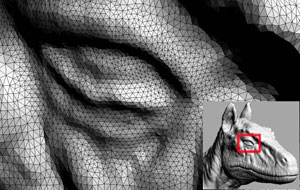
Ah the humble triangle. This simple shape is one of the first we ever learn. But perhaps you didn't realise just how important triangles are...
A triangle is a three-sided polygon and comes in a variety of flavours. Some are to do with the length of the triangle's sides: equilateral — where all the sides (and all the angles) are the same size; isosceles — where two of the sides (and two of the angles) are the same size; and scalene — where none of the sides (or angles) are the same. The angles inside the triangle are also important. All the angles add to 180°. You can have acute triangles, where all the angles are less than 90° and obtuse triangles, where one of the angles is greater than 90°. And of course you can get right-angled triangles — one of the most important mathematical shapes inspiring Pythagoras' Theorem and trigonometry.
But triangles aren't just mathematically significant, they are also fundamental to the way we build in our environments, both physical and virtual. Triangles are special because they are exceptionally strong. Out of all the two-dimensional shapes we can make out of straight struts of metal, only a triangle is rigid. All other shapes can be deformed with a simple push if the shape is hinged at the corners (eg. a rectangle could be pushed over into a parallelogram). But not the trusty triangle, which explains its ubiquitous use in construction from pylons to bracing.
Triangles are also special because they are the simplest polygon — it is a common approach to a tricky geometrical problem, such as analysing a complex surface, to instead approximate it by a mesh of triangles. This approach is also used in the real world to achieve some of the exotic shapes we now see in modern architecture, such as the curved shape of 30 St Mary's Axe, aka the Gherkin, or the canopy over the courtyard in the British Museum.
This method of triangulation also is vital in building our virtual world. The fluid forms of the CGI characters we see in film and on TV are actually an incredibly fine mesh of triangles, in order that they can be stored and manipulated digitally.
Triangles — the simplest shape that makes our mathematical, physical and digital worlds go round.
You can read more about triangle strength and their role in our physical and virtual worlds on Plus. And you can find out all about their role in mathematics at Wolfram MathWorld.
Translation
Arabic: https://goo.gl/E6CaFR